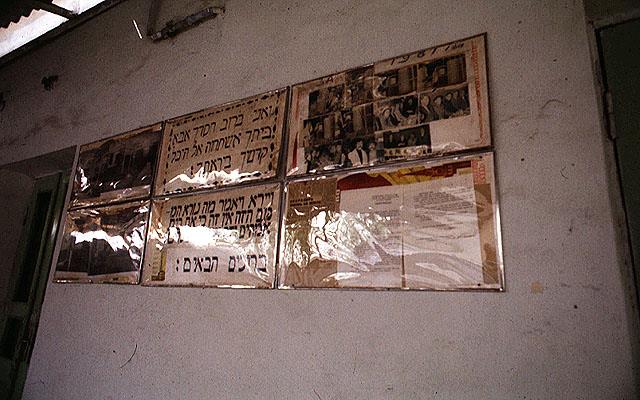
Photo exhibition dated 1981 in the courtyard of the Synagogue on 62 Gorbunova street, Tashkent, Uzbekistan, USSR, 1983
Photo: Dr. Theodore Cohen, USA
The Oster Visual Documentation Center, ANU – Museum of the Jewish People, courtesy of Dr. Theodore Cohen, USA
Image Purchase: For more details about image purchasing Click here, make sure you have the photo ID number (as appear above)
Tashkent
(Place)Tashkent
The capital and largest city of Uzbekistan
Before the Russian conquest of 1865 there had been a small community of Bukharan Jews living in a special quarter in the city. Russian rule improved the legal status of the Jews, and many Jews from neighboring Bukhara consequently settled in Tashkent. Although under czarist rule Jews from European Russia were prohibited from settling in Tashkent, a small community of Russian Jews who had been categorized as being allowed to settle outside of the Pale of Settlement was formed in Tashkent during the second half of the 19th century. In 1897 there were 1,746 Jews in the region of Tashkent, most of whom lived in the city itself.
On the eve of World War I, about 3,000 Jews lived in Tashkent. They ran Jewish educational and cultural institutions, in which the language of instruction was Hebrew. A Bukhori-language (a Judeo-Tajik dialect spoken by Bukharan Jews, including those in Tashkent) Zionist newspaper, Rachamim, was published in the region and read by the Jews of the community.
Under Soviet rule the Jewish cultural and religious institutions were gradually suppressed, and the Zionist newspaper was replaced by a communist one, Bairaki Huriet ("The Flag of Freedom"). During the 1920s and 1930s Tashkent became one of the main areas where active members of Zionist organizations and members of youth movements were exiled.
During World War II, Tashkent became one of the most important absorption centers for refugees from the German-occupied regions. Many remained in the city after the war, which resulted in the creation of a large Jewish community. The 1959 census found that 50,445 Jews were registered in Tashkent (5.5% of the total population); most of them newly-arrived Ashkenazi Jews, while a minority were native Bukharan Jews. There was one synagogue for Ashkenazim, and two for Bukharans, all located in the same compound.
In 1963 the authorities prohibited organized matzah-baking, but the Jews of Tashkent continued to bake matzah at home. The synagogue buildings were damaged in a 1966 earthquake; the Bukharan Jews repaired their synagogue, while the Ashkenazim moved to a new synagogue building.
Particularly after 1968, many Jews from Tashkent applied for exit permits to Israel. In 1997, after the major waves of Aliyah to Israel, there were 23,000 Jews in Tashkent.
The capital and largest city of Uzbekistan
Before the Russian conquest of 1865 there had been a small community of Bukharan Jews living in a special quarter in the city. Russian rule improved the legal status of the Jews, and many Jews from neighboring Bukhara consequently settled in Tashkent. Although under czarist rule Jews from European Russia were prohibited from settling in Tashkent, a small community of Russian Jews who had been categorized as being allowed to settle outside of the Pale of Settlement was formed in Tashkent during the second half of the 19th century. In 1897 there were 1,746 Jews in the region of Tashkent, most of whom lived in the city itself.
On the eve of World War I, about 3,000 Jews lived in Tashkent. They ran Jewish educational and cultural institutions, in which the language of instruction was Hebrew. A Bukhori-language (a Judeo-Tajik dialect spoken by Bukharan Jews, including those in Tashkent) Zionist newspaper, Rachamim, was published in the region and read by the Jews of the community.
Under Soviet rule the Jewish cultural and religious institutions were gradually suppressed, and the Zionist newspaper was replaced by a communist one, Bairaki Huriet ("The Flag of Freedom"). During the 1920s and 1930s Tashkent became one of the main areas where active members of Zionist organizations and members of youth movements were exiled.
During World War II, Tashkent became one of the most important absorption centers for refugees from the German-occupied regions. Many remained in the city after the war, which resulted in the creation of a large Jewish community. The 1959 census found that 50,445 Jews were registered in Tashkent (5.5% of the total population); most of them newly-arrived Ashkenazi Jews, while a minority were native Bukharan Jews. There was one synagogue for Ashkenazim, and two for Bukharans, all located in the same compound.
In 1963 the authorities prohibited organized matzah-baking, but the Jews of Tashkent continued to bake matzah at home. The synagogue buildings were damaged in a 1966 earthquake; the Bukharan Jews repaired their synagogue, while the Ashkenazim moved to a new synagogue building.
Particularly after 1968, many Jews from Tashkent applied for exit permits to Israel. In 1997, after the major waves of Aliyah to Israel, there were 23,000 Jews in Tashkent.